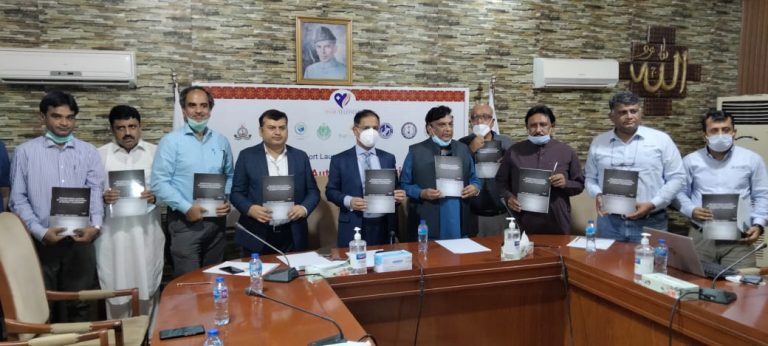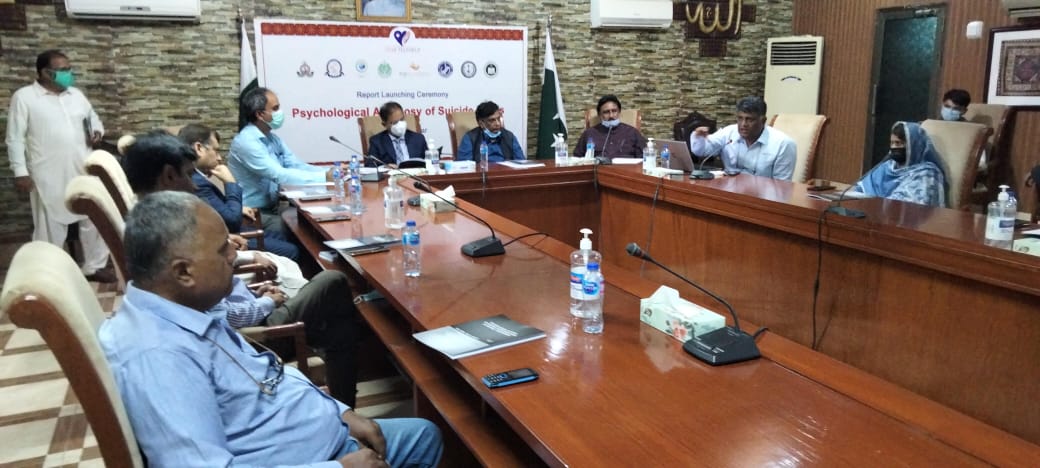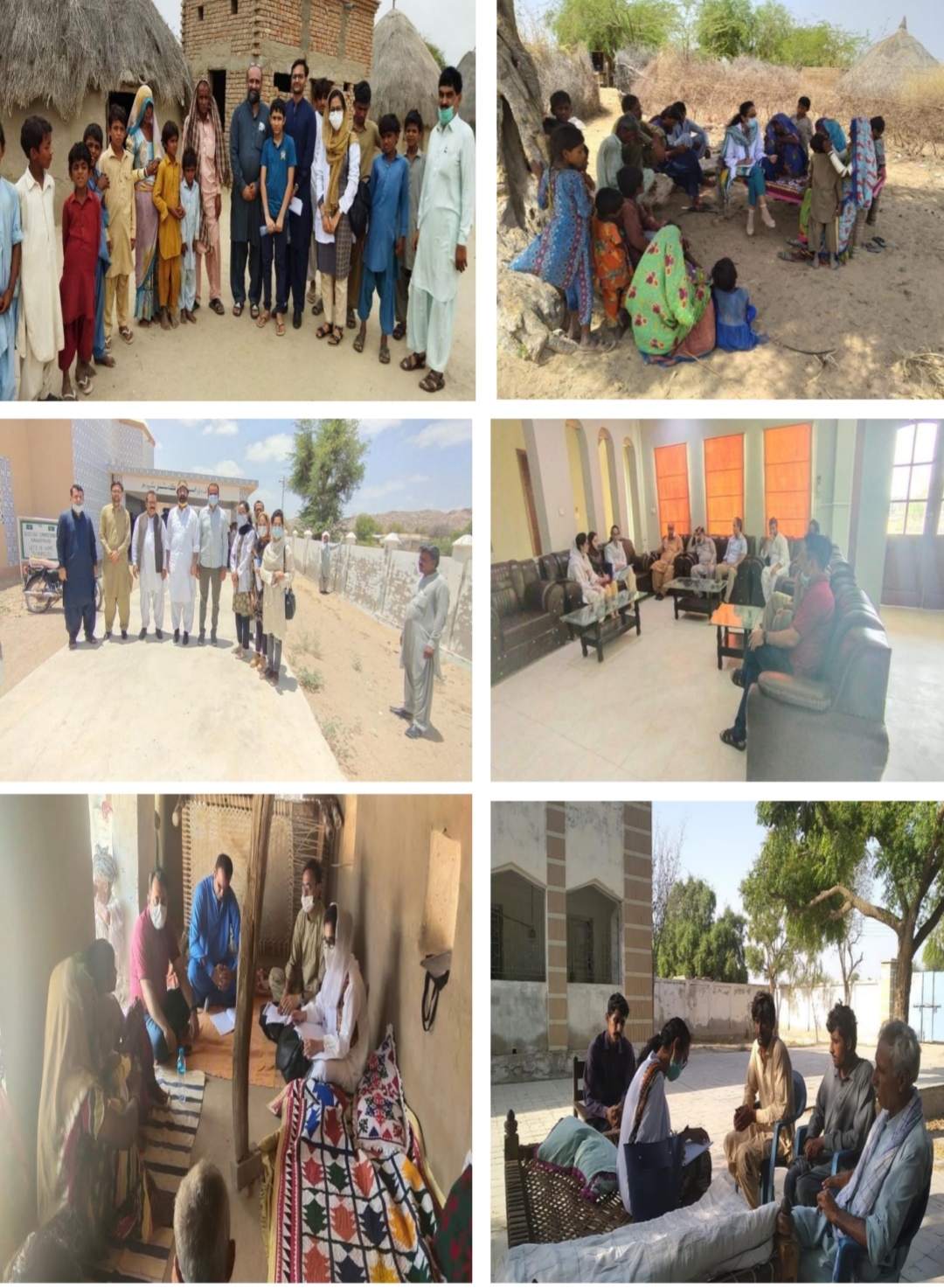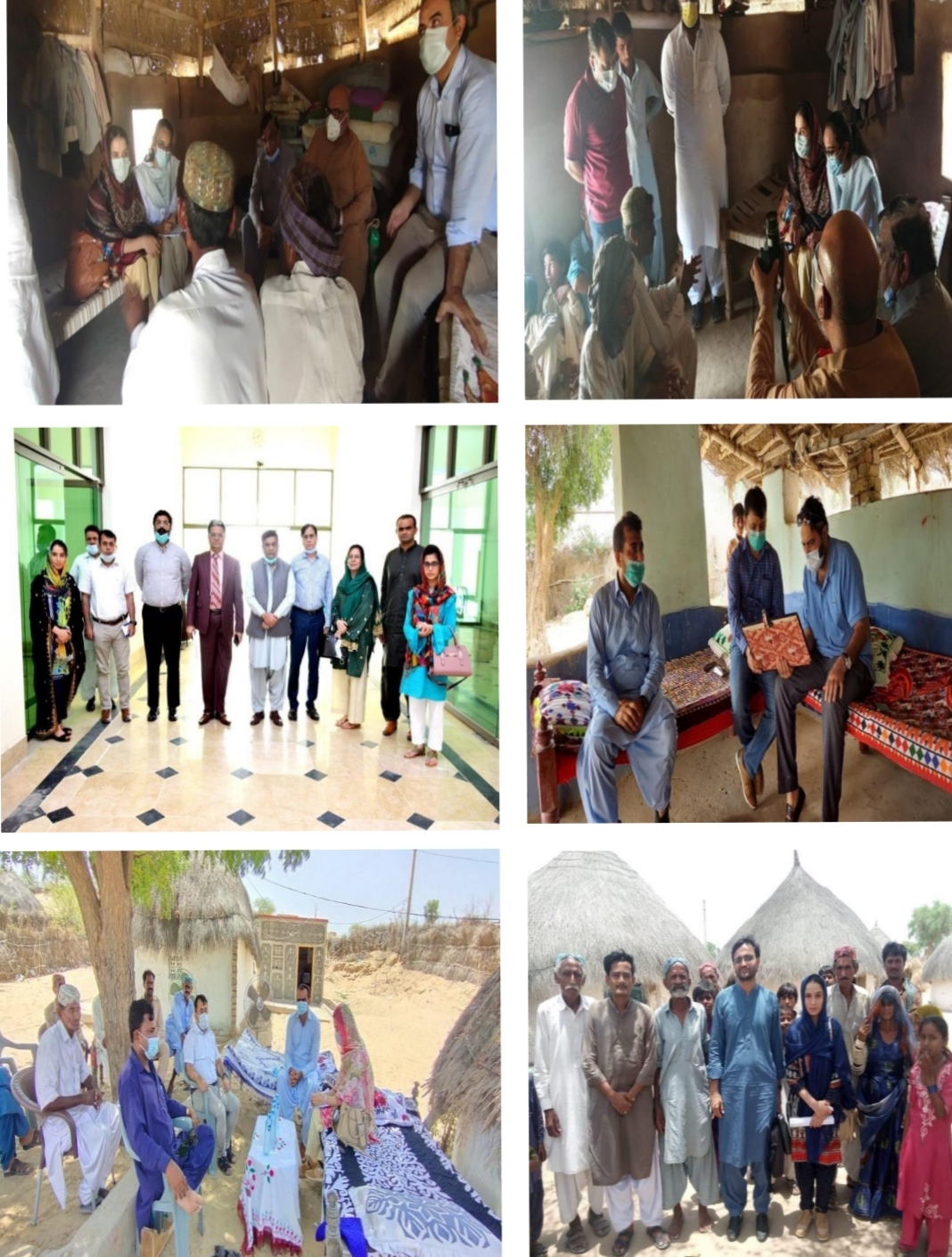
According to report 24% victims had expressed their wish to die due to critical situation including financial constraints, chronic physical or mental health problems and social difficulties. In one case of suicide of teenager, he wished to die in order to meet his grandparents in next life.
48 Percent of the total Suicide Victims were teenagers
Thirty-three suicide cases were identified for psychological autopsy in 31 villages of Mithi, Islamkot, Nagarparkar, Diplo, Chhachhro and Kaloi Talukas of Tharparkar – Dr. Karim Khawaja, Chairman, SMHA
By GR Junejo
Mithi: Sindh Mental Health Authority (SMHA) released here on Monday the findings of Psychological Autopsy of suicide cases carried out in Tharparkar district, according to which majority of the selected persons who ended their life, were suffering from different mental disorders.
There were thirty-three registered cases of suicide identified for Psychological Autopsy, of which 21 were females and 12 males with female and male cases ratio of 64% and 36% respectively.
The survey team had visited 14 villages of taluka Islamkot, 05 of Mithi, 04 of Diplo, 03 of Nagarparkar, 04 of Chhachhro and 01 of Taluka Kaloi where these cases were reported. The villages include Dadiyo Halepoto, Mitha Tarr, Samu Bheel and Sookhro of Chhacchro Taluka, Konral, Sadio, Turkni and Jiharo of Diplo Taluka, Haji Khan village of Kaloi Taluka, Borli Ilyas Tani, Harinyari and Kharsar village of Nagarparkar, village Bhakuo, Detha, Khoro Bajer, Manisar and Phool Tarai of Mithi Takuka while Bhano Dhani, Bhojasar, Haji Khan, Jeando Dars, Lasrio, Manjthi, Mansingh Bheel, Meghani Colony, Mehar Bajer, Mehayar, Peero Tarr, Shiv Colony, Taryano and Wali Jo Tarr of Islamkot Taluka.
According to report, of the selected suicide cases, 14 female (42.5%) and 09 male (27.5%) belonged to Hindu religion who constituted about 70% portion of the sample size. The number of Muslim cases was 07 female and 03 male or 30% of the total sample size of this study. Moreover, 12 victims of the total sample size were single including o7 male and 05 female while 14 victims were married including 12 females and 02 males besides 03 males and 02 females engaged and 02 females were divorced.
 According to statistics 24% of suicide victims had mental illness and were suffering from un-diagnosed mood disorder and psychotic illnesses. One case among them was diagnosed as schizophrenia – a chronic psychotic illness. Among them, around 18% of suicide victims had been suffering un-diagnosed psychotic disorders and remaining 6% of victims were facing mood and anxiety problems.
According to statistics 24% of suicide victims had mental illness and were suffering from un-diagnosed mood disorder and psychotic illnesses. One case among them was diagnosed as schizophrenia – a chronic psychotic illness. Among them, around 18% of suicide victims had been suffering un-diagnosed psychotic disorders and remaining 6% of victims were facing mood and anxiety problems.
There had been 02 cases of neurological conditions, illness resembling undiagnosed epilepsy and mentally retarded respectively.
Rest of 06 suicide victims were patient of psychotic disorder except one case of diagnosed schizophrenia.
According to survey 24% victims expressed their wish to die due to critical situation including financial constraints, chronic physical or mental health problems and social difficulties. In one case of suicide of teenager, he wished to die in order to meet his grandparents in next life.
There were 36% victims who faced proximal stressors which led up to suicide. The victims were bearing the visible mental burden and pressure in form of chronic mental illness, adolescent crises, domestic problems, financial problems, unemployment, concern for conceiving baby, unwanted pregnancy in love affair, and marriages of daughters under ‘watta satta’ (Marriages in Exchange), the reasons that broke them brutally.
Among all cases of suicide, there was one case of 16-year boy who committed suicide due to failure in love and had unwanted pregnancy. In another cases, watta satta, cousin marriages, and failing in getting approval for marriage from the head of the family were the reasons.
In whole study, the teams found only one case of disability with limb amputated. The subject was 17 years old first born among 5 siblings; he worked as a laborer in agriculture field and his income was Rs.6000/- per month. His family also had liability of loan amounting Rs.70000/- .
Subject was severely concerned about his artificial limb installation and hunt for appropriate job to pay off loan on priority basis and moving ahead to receive good opportunities for better life.
The report further revealed that around 42% were married. Some 16 individuals or 48 percent were in the age group of 10-to-16; and 12 individuals or 36 percent were age group of 21 to 30 years. Around 45.5% females and 15% males had no formal education. Almost 60% females were housewives while 40% of victims were labor, peasant, employee and small scale business owners. Around 55% victims of suicide were part of nuclear families, 33% were living in joint family system and 12% of victims associated with extended family system. About 33% cases reportedly had no close relation with any person.
In terms of method of suicide, 73% victims hanged themselves.
About 33% subjects participated actively in religious and cultural events. It was noted that 15% of suicide victims had attempted suicide previously before completed suicide (female – male ratio 4:1). Study found 52% suicides were pre-planned and 48% suicides were sudden and impulsive act as described by the family members. About 6% victims had left messages before suicide. The family members described 12% subjects to have unstable relationship. The month of April and May were crucial during which high numbers of suicide cases were recorded. Among the family members and survivors, 33% reported uncontrollable grief and bereavement, while 6% received some sort of formal mental health care.

Dr. Karim Khawaja, Chairman, SMHA, who released the report of Psychological Autopsy of suicide cases at a ceremony here at DC office, said in his address that Psychological Autopsy was first of its kind carried out in Pakistan. “We had decided to undertake the Psychological Autopsy after the findings of a Study of Registered Cases of Suicide between The Period Of 2016 – 2020 across the province of Sindh.”
“The findings were very disquieting as it was noted that District Tharparkar ranked top with 79 suicidal deaths in single year of 2020, with 48 female and 31 male deaths, followed by districts of Badin, Dadu, Mirpurkhass, Sanghar, UmerKot, Tando Allahyar and Tando Muhammad Khan. Malir also ranked first in Karachi division with 24 suicide cases in the same period, out of total 75 deaths reported due to suicide between periods of 2016 to 2020 in Karachi.”
“After the publication of report on suicide rates in last five years across province, SMHA explored the reasons to establish facts on scientific basis. SMHA, working with reputable institutions of psychiatry, psychology, sociology, and corporate sector supporting the health care sector, framed the issue for more in-depth inquiry,” he told.
Dr. Karim Khawaja said that the main purpose of carrying out psychological autopsy was to ascertain the factors which emotionally or psychologically instigate a person to commit suicide. “We applied the scientific technique of probing an individual’s death to know what the person thought, felt, and did before death, and the procedure was based on information gathered from personal documents, police reports, medical recorders and face to face interviews to families, friends, and others who had contact with the person before the death”.
“Psychological autopsy evaluated the grounds of death observing the circumstances, natural or unnatural, that led to death,” he added.
There have been observed many gaps in recording of data of suicide cases at concerned offices. There is no uniformity in format, no fully compilation of data in columns of format of victim profile. Data of victim has also been limited to obtaining information from District Health Offices and District Police Offices of Sindh and many cases reported in media and private hospitals and even not reported by families of victims are not recorded.
“In such a situation we need more strategic planning and decision making to reduce suicide cases,” he said.
“In light of this study, Sindh government and health department need to come to devise strategies and the policy for new innovative approach to control the situation,” he said adding that SMHA would advocate for legislation, which include regulations of weapons, reducing availability of illicit drugs/substances, safe use of pesticides and insecticide, installation of caps to cover the well on priority basis across the province to prevent the suicide cases.
“We also intend to get the law passed for decriminalizing the attempted self-harm. This is vital because Section 325 of the Pakistan Penal Code is a strong deterrent for most people against seeking medical help,” he said.
Dr. Karim Khawaja said the Sindh government will have to set up effective surveillance system for documenting the suicide cases maintaining good linkages between the health, human rights, police and legal departments through development of software/application. Moreover community mobilization, extra curriculum activities, science festivals, sport gala, debate competitions, essay writing and de-stigmatization of mental illness, essential trainings for teachers, parents and police personnel for identifying high risk cases, training to lady health workers by trained mental health professionals would also bear positive results.
The report also underlined devising a strategy for mental health services in prisons, orphanages, Darul Amans and juvenile correctional centers, to reduce the risk of suicide cases.
MPA Fakir Sher Muhammad Bilalani, Deputy Commissioner Muhammad Nawaz Soho, and others also addressed the ceremony. Fakir Sher Muhammad in his address said the parents and heirs of suicide victim often insist not to register cases and avoid conducting psychological or physical autopsy. DC Muhammad Nawaz Soho opined that evidence-based policy-making will help to address this challenging issue and called for also carrying out such studies in prisons.
Dr. Ali Wasif, Psychiatrist, other members of advisory team, observers and the members of survey team were present.  SMHA conducted the Psychological Autopsy of registered cases of suicide in collaboration with Liaquat University of Medical and Health Sciences (LUMHS) Jamshoro, Dow University of Health Sciences (DUHS), Jinnah Postgraduate Medical Center Karachi (JPMC), Sir Cowasji Jahangir Institute of Psychiatry and Behavioral Sciences Hyderabad, University of Sindh and Sindh Engro Coal Mining Company (SECMC) and Thar Foundation.
SMHA conducted the Psychological Autopsy of registered cases of suicide in collaboration with Liaquat University of Medical and Health Sciences (LUMHS) Jamshoro, Dow University of Health Sciences (DUHS), Jinnah Postgraduate Medical Center Karachi (JPMC), Sir Cowasji Jahangir Institute of Psychiatry and Behavioral Sciences Hyderabad, University of Sindh and Sindh Engro Coal Mining Company (SECMC) and Thar Foundation.
An Advisory Committee was also formed consisting of Prof. Dr. Bikha Ram Devrajani, Vice Chancellor LUMHS, Associate Professor Dr. Chunni Lal, Chairman, Department of Psychiatry, JPMC, Dr. Syed Ali Wasif, Consultant Psychiatrist, Dr. Suleman Otho, Consultant (SMHA) & Public Health Professional, Dr. Suresh, Ex- Additional Secretary Health, Govt. of Sindh, Mohsin Babar, Manager (Media and Communication, SECMC).
Muhammad Usman Chachar, Additional Chief Secretary (Home), Qazi Shaihd Pervez, Secretary Home, Muhammad Nawaz Soho, Deputy Commissioner, District Tharparkar, Rajesh Koyal, Assistant Commissioner Taluka Mithi, Sami Ullah Sanjrani, Assistant Commissioner Taluka Islamkot, Abdul Hameed Mughal, Assistant Commissioner Taluka Nagarparkar, Dr. Gordan Das, District Health Officer, Dr. Gul Muneer Vistro, Medical Superintendent, Dr. Bharat Kumar, Psychiatrist, Civil Hospital Tharparker and other officers had extended their cooperation in carrying out the Psychological Autopsy.
The team members included Naseer Memon, GM (CSR) Sindh Engro Coal Mining Company (SECMC), Ali Murad Talpur, Research Coordinator, Field Supervision & Author, Consultant Sindh Mental Health Authority (SMHA), Prof. Dr. Haider. A Naqvi, Chairman, Department of Psychiatry, DUHS, Prof. Dr. Iqbal Afridi, Chairman (R), Department of Psychiatry, JPMC, Prof. Dr. Irfana Shah, Chairperson, Department of Psychology, University of Sindh, Jamshoro, and Asst. Prof. Dr. Jamil Junejo, Department of Psychiatry, LUMHS.
The survey team consisted of Mr. Fayaz Sheikh Govt. and Community Liaising Program Officer (Health) Sindh Engro Coal Mining Company (SECMC), Dr. Kheenpal Das, Asst. Professor, Department of Psychiatry, DUHS, Dr. Manisha Dharmani, Department of Psychiatry, JPMC, Dr. Sapna Herani, Department of Psychiatry, DUHS, Rabdino Manghrio, Teaching Assistant, Department of Psychology University of Sindh, Ms. Alina, Field Assistant, Student, Department of Psychology University of Sindh, Dr. Daim Jaipal, Field Monitoring & Data Validation, Department of Psychiatry, LUHMS while Faisal Edhi Participant CEO, Edhi Foundation, Dr. Amir Dabir, Medical Superintendent, Dr. Qalb e Haider, Psychiatrist, Dr. Parveen Channar, Psychiatrist, Dr. Nilofar Memon, Abdul Razaq Nohrio (All from Pharmacist Sir Cowasjee Jahangir Institute of Psychiatry) and Dr. Shehryar Qambrani, LUMHS were the field observers.
___________________